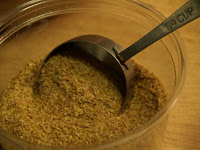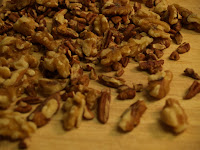I apologize in advance and warn you that this is an extremely nerdy post about canning. Aaron is always bored to death when I go into detail about my discoveries or tales of canning in the kitchen (he tells me I sound like an old lady). While he may find it dull, he certainly has nothing but good things to say about the finished product. I find canning fascinating and fun, and figured there might be a few other kitchen geeks out there who could relate to my nerdiness and benefit from it as well. It will serve as a reference for canning recipes in future posts.
When I first started canning, I found a wealth of information on the subject, but at times, found it to be a bit overwhelming and somewhat contradictory. Sometimes the basic steps or tricks most veteran canners take for granted, leave the new-be’s at a loss, not to mention terrified of botulism. In fact, the risk of botulism was my biggest fear when I first began. What if I poisoned my friends and family!? (For those of you who don't know, botulism is a serious and potentially deadly form of food poisoning due to bacterial growth in food. This is why we can, to kill bacteria and food spores, which allows us to keep food safe to eat for up to a year. For more information on the subject see here). But as long as you're using a reputable recipe and follow proper canning procedures, you have nothing to fear but fear itself!
What I’ve tried to do here it put into writing each step I go through when canning, keeping in mind the questions or concerns I had when I first began. What I think most people will discover, is that depending on what you're canning, it can be quite simple, very fast, and doesn’t have to dirty a million pots and pans.
What I’ve tried to do here it put into writing each step I go through when canning, keeping in mind the questions or concerns I had when I first began. What I think most people will discover, is that depending on what you're canning, it can be quite simple, very fast, and doesn’t have to dirty a million pots and pans.
Unfortunately, for most of us, the knowledge of canning was lost with our grandparent’s generation. This knowledge would have been passed down to us and never would have seemed scary or intimidating, as it often can be today. My grandparents used to can during World War II, and even built a shack in their backyard for large-scale production. During the war, the home cook was highly encouraged to preserve their own food, for it was not only economical, but spared more food for soldiers overseas. Today, it continues to be economical and while we no longer need to can for necessity, we do it to capture peak of season flavor and for the freedom it gives the home cook to create and preserve their own food. It’s both personal and personalized! Once you get the basic steps down, you can apply them to almost every type of canning recipe.
STEP-BY-STEP GUIDE TO CANNING:
What you’ll need (most of it you probably already have):
- Large stockpot with a tight-fitting lid- large enough to hold however many jars you’ll be canning at one time (so they’re not touching), and to allow at least 1 inch of boiling water to cover the size jars you’ll be using.
- Medium sized pot with a lid- to hold your lids and screw bands.
- Jar rack- available at most hardware and kitchen supply stores. In place of a jar rack you can use a couple of clean dishtowels and place them on the bottom of the pot. However, I find this method to be somewhat difficult. When your water-bath is at a rolling boil, the towels have a tendency to float up to the top. Also, I can’t fit as many jars in my pot with the towels bunched up at the bottom. I use neither of these methods and instead place a circular drying rack on the bottom of my pot. Any of these methods is fine- they simply provide a barrier between the bottom of the pot and the jars, preventing breakage.
- Jar lifters- allow you to take your jars in and out of your water-bath canner without acquiring third degree burns.
- Magnetic lid lifter (or wand)- this allows you to remove your lids from hot water. Such a handy gadget!
- Jar funnel- these funnels fit the mouth of all mason jars and make filling them much easier and less messy.
- Ladle- for transferring your food to the jars you’ll be canning them in.
- Tongs- used to remove your sterilized equipment (jar lifters, lid extractor, funnel, and ladle) from boiling water.
- Plastic knife (the to-go kind) or spatula- used to slide down the inside of your jar, once filled, to extract air bubbles.
- Jars (mason jars)- come in a variety of sizes and are specially made to withstand the high heat of your water-bath canner. Choose ones appropriate for what you’re canning- your recipe will tell you this. (I always have an extra jar cleaned and ready just incase you have more of whatever you’re canning than the recipe indicated).
- A large metal bowl- I like to fill this with hot soapy water to use as a basin to wash my jars, lids, and screw bands.
- Clean sponge- for washing jars, lids, and screw bands (I reserve one especially for this task).
- Clean dishtowels for laying on your clean counter.
- Paper towels for wiping the rim of your jars before placing on the lid.
Setting up:
Start by wiping down and sanitizing your kitchen counters and placing clean dishtowels on your work surface. Position your drying rack at the bottom of your large stock pot and fill it with enough water to cover whichever size jars you’ll be using by at least 1 inch (I like 2 inches just to be safe). Place the lid on and turn your burner on high. It usually takes 20 to 30 minutes for a pot of water this size to come to a roiling boil.
In the meantime, fill a large metal bowl with hot soapy water and toss in your jar lids and screw bands. Using a sponge, clean your jars with the soapy water and set aside on your clean dishtowels. Wash your screw bands and lids in the same manner (You can avoid this step if you want to run your jars through the dishwasher. For some reason, I prefer to do it by hand).
Fill your medium sized pot with water, cover, and bring to a boil. Turn the heat off once the water begins to boil. Add your jar lids and rings to the hot water and cover.
Once your stockpot has come to a rolling boil, add your jar lifters, magnetic lid lifter, jar funnel, and ladle. Boil for 10 minutes to sterilize. After 10 minutes, turn the heat off and using tongs, remove the rest of your sterilized equipment and set aside on clean dishtowels.
Next, using your jar lifters, add your clean jars to the stockpot and cover. Return to a boil. Continue to boil for 10 minutes to sterilize. After 10 minutes, turn the heat off, but leave the jars in the pot to stay hot until ready to be filled. (Note: you can skip this step only if you’re going to be processing your jars for 10 minutes or more. The canning process will kill any bacteria during that time. But you still need to keep your jars in hot water until ready to use). Now you’re ready to can- be sure to follow recipes closely and process jars for the appropriate time.
Filling your jars and Processing:
Start by removing one jar from your stockpot using the jar lifters. Place on a clean towel and put jar funnel on jar. Ladle in whatever you’re canning and allow the proper headspace (again, your recipe should tell you how much headspace to allow. Generally it’s ¼ inch for sweet preserves, and ½ inch for just about everything else). Remove funnel, set aside, and using a small spatula or plastic knife, remove any air bubbles- they will float to the top. Wipe the rim of your jar with a paper towel. (This step is very important for it provides a clean rim for your lids to seal). Using the magnetic lid lifter, remove a lid from the hot water and place it on the jar. Screw on the screw band so it’s snug, but not tight (if its too tight, not enough air will escape during canning). Use the jar lifter to place the jar back into the large stockpot of hot water. Continue in the same manner until all of your jars are filled. Cover your stockpot and return to a roiling boil. Once the water has returned to a rolling boiling, you can set your timer for the processing time provided in whichever recipe you're using (processing times vary depending on jar size, what you’re canning, and altitude). If you're unsure of your altitude, enter your zip code here to find out. For examples describing processing times in accordance with altitude, see here. If you live at or below 1000 ft., simply follow the processing time given in the recipe.
After the processing time is over, turn the heat off and remove the lid (open it away from you so you don’t burn your face) and let the jars sit in the pot for a few minutes to settle before removing them with your jar lifters. Place your processed jars on a towel (not a cold surface, otherwise they could break) and leave undisturbed for 12 to 24 hours. (You’ll probably hear the satisfying pop of the lids sealing as they cool).
Storing your jars:
The next day, or after 12 to 24 hours, check to see that your jars have good seals. Press the center down on each lid to see that it’s inverted. Any that seem faulty should be placed in the refrigerator and eaten within 3 weeks. It’s a good idea to remove the rings from your jars or at least leave them very loose (they are no longer necessary because the sealing compound on the rings is airtight due to the canning process). It’s easier to tell if a jar has “gone bad” if the rings are off, because the lid will pop up. Sometimes if the rings are too tight it can be more difficult to notice. Label and date your jars and store in a cool dry place (not near a hot stove or any heat source).
Most canned goods need to be consumed within 1 year. Once you open your jars, store in the refrigerator and consume within 3 weeks. There should be no problem with spoilage if you’ve taken the proper precautions, but it’s still a good idea to examine your jars before eating. Bulging lids or any leakage from the jars are cause for worry and should be discarded. Also, don’t eat a canned good that has mold on the surface or emits bad smells. After opening, you can reuse the jars and screw bands, but lids should be discarded after use. You can buy replacement lids at most hardware and kitchen supply stores, or online.
Canning books or sites I love:
The Complete Book of Small-Batch Preserving, by Ellie Top & Margaret Howard
The Ball Complete Book of Home Preserving, by Judy Kingry & Lauren Devine
The River Cottage Preserves Handbook, by Pam Corbin




















